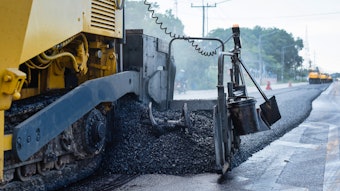
Often located in remote areas with limited entry points and significant space constraints, paving bike paths can pose several challenges to the most skilled contractor. In a recent project for Linn County Conservation contractor LL Pelling maneuvered through the challenges to successfully pave a 7 mile, 10-foot wide bike path.
Headquartered in North Liberty, IA, LL Pelling has been completing work around the Iowa City/Cedar Rapids Corridor area since 1949. With three asphalt plants located in Iowa City, Cedar Rapids and Marion, LL Pelling completes projects ranging from highways to airports to parking lots.
“We are a full-service contractor offering services including parking lot striping and chip seal,” says Chuck Finnegan, president. “We currently have four asphalt paving crews and one concrete crew that completes curb and gutter work associated with the asphalt projects.”
Paving the Linn County Conservation bike path
Due to the general contractor’s schedule, LL Pelling completed the paving work in two phases with the first taking place in May and finishing the project in early July. The general contractor completed all of the subgrade work while LL Pelling completed the paving portion of the project. Crews laid 9,000 tons of hot mix asphalt in one, 4-inch lift at a rate of ½ to ¾ mile per day.
“The project was located on an old railroad bed that was used forty years ago, and it hasn’t been used by the railroad for many years,” says Joel Gryp, Project Manager at LL Pelling. “The trail stretches seven miles and has seven different sections that are intersected by county gravel roads.”
Prior to completing the paving work, a crew came to the site to clear the path of any obstructions.
Various locations of the path were more susceptible to flooding; as a result, LL Pelling installed two, 500-foot sections of porous asphalt. These sections were located in low-lying areas that were banked on both sides. “We didn’t have a lot of room to do ditching in those areas so it was decided to put some sub-surface drainage in with porous asphalt,” Gryp says.
The porous asphalt base consisted of 12-18 inch coarse stone with the top two inches choked off with a 3/8-inch clean chip. “We used the 3/8-inch clean chip because it carried the load a little better without displacing the material,” Gryp says. “It all allows the water to run down the subsoil and be absorbed into the soil. The principle behind the porous asphalt is to direct the water away from the surface and down into the sub-base.”
Laying down porous asphalt is fairly similar to hot mix asphalt. “There aren’t too many differences between the two mixes,” Gryp says. “It’s basically only a different mix. For the porous asphalt we used a polymer PG 64-28 that has a higher asphalt cement content and more voids compared to a conventional mix. As far as construction, it is placed the same as conventional mixes but is compacted less.”
Prior to this project, LL Pelling had laid a few test patches of porous asphalt at its facility, and this was the first time that Linn County utilized the porous asphalt mix. According to Finnegan, the porous asphalt mix is designed by the quality control staff at LL Pelling.
Key equipment used on the trail project included a RP-195 Roadtec paver, a rubber/steel combination Hamm roller, and a Sakai SW850 finishing roller.
Initially, crews operated with only the Sakai SW850 finishing roller. However, the first day of paving they encountered some issues with the smoothness. As a result, the crews brought in the rubber/steel combination Hamm roller to assist with achieving a smoother surface.
Adjusting to the space restrictions
With every project comes a few challenges, and LL Pelling was faced with overcoming space constraints. The limited access as well as the size and weight of the equipment was incredibly difficult. “Our biggest challenge was getting the material back to the paver,” Gryp says. “There were several sections with only county roads, every mile, to use as access points. We would have to back the trucks down one at a time off of those gravel roads.”
Backing the trucks in one at a time put added stress on the grade. “They were all backing in on the same spot because the trail was only 10 feet wide,” Gryp says. “We occasionally had to do some minor grading in front of the paver to repair the grade making it suitable to pave on. Anytime you’re adjusting the grade you run into smoothness difficulties.”
For other contractors to adjust to the space constraints, Gryp suggests creating as many turnouts or areas for the trucks to go off the side of the trail. “We’ve completed a few bike trails where we made those into stops for benches,” he says. “This allowed our trucks to back off onto a side and other trucks could pass by removing the chance of meeting each other or having to move one truck at a time.”




























